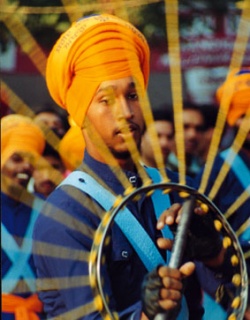Shastar
From SikhiWiki
Jump to navigationJump to search
Shastar or Shaster means Weapons both defensive and for attacking. This is a Punjabi word for weapon.
Below is a list of some common Shastars (Weapons) used in Gatka training and displays:
- Barcha — The spear is a long shafted weapon and has a hook at the spearhead used to pull away the opponent's shield.
- Dahl or Shield. It is nearly always round and varies in diameter from about eight inches to about twenty-four. Some are very nearly flat while others are strongly convex. The edges may be flat or rolled back in the reverse curvature of the shield. It is held by two handles fastened to ring bolds that pass through the shield and are riveted to bosses on the outside, sometimes formed to spikes. Between the handles there is a square cushion for the knuckles to rest against. The handles are so placed that, when tightly grasped, they force the backs of the fingers against the cushion giving a very firm and comfortable hold. These shields are nearly always of steel or leather.
- Gurj or Mace: Indian maces have great variations in their shape. From simply curved steel bars to Persian influenced maces with openings in the head which gives a whistling sound when the blow was struck to plane massive heads. They often have guard hilts like the Khanda
- Katar - The Katar is a double-edged and straight bladed dagger used to pierce armour. The handle has two sidebars to provide protection and a better grip.
- Chakkar or Chakram - There are two main versions of the chakkar. The chakram or "chotta chakkar" or "small wheel" is a flat steel ring, five to 12 inches in diameter, from half an inch to an inch and a half wide, and with a sharp outer edge. While not being used, it is carried "fixed" to the Turban. Several of different sizes were often carried on a pointed turban, the "dastar ungaa" or behind the back. It is held between the thumb and index finger and thrown towards the opponent with an underhand flick. Thrown with sufficient force and accuracy it can cut off a green bamboo three-quarter of an inch in diameter at a distance of thirty yards.
The vadda Chakar or the "big wheel" looks like a wagon wheel with weights at the end of each spoke. In battle the ends of the spokes carry sharp cutting blades. The chakar is wielded by grasping the centre and spinning it around, causing damage upon anyone coming too close to the spinning weights or blades. The wheel when in full motion presents a very dangerous weapon to approach. The operator is also able to throw this into the enemy causing widespread damage.
- Khanda - This is a typical Indian sword and has a broad, straight blade, usually widening towards the point, which is blunt. Sometimes it is also double-edged.
- Kirpan - The Kirpan is a short curved dagger and all Sikhs are required to carry it by tradition.
- Lathi - The lathi or quarterstaff is a wooden stick as tall as the warrior and made of oak.
- Marati - Trainig device: The Marati is a bamboo stick with wooden or cloth balls on its ends. It is mainly used for training purposes but there are variations with blades or burning cloth on its ends, to attack and distract elephants and for psychological warfare.
- Soti - This is made from fire hardened bamboo or ratan, 1m long and usually has a hand guard. It is mainly used for practice and "playing Gatka", the training fight. For combat they were replaced by oak ore ironwood sticks, without hand guards.
- Tapar - The battle-axe is very distinct from the normal axe and sometimes has a dagger concealed in the handle.
- Talwar - The sword is usually curved with a thin and sharp blade. The Talwar is greatly respected and treated with care.
- Tir Kaman - The bow and arrow is a potent weapon. The arrow is made of steel heads with reed shafts. The bow is also composite and made of layers of wood and steel.



